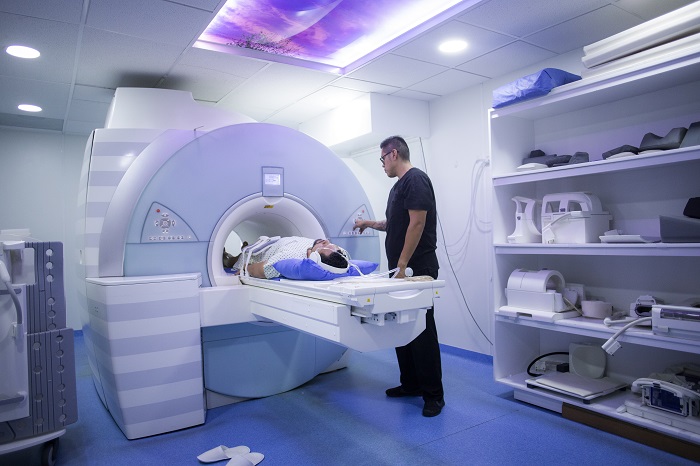Office of Research & Development |
 |


Photo: ©iStock/DarioGaona
October 10, 2024
By Tristan Horrom
VA Research Communications
"Provider education regarding these known adverse events [of gadolinium exposure] is critical, and informing patients of these risks and outcomes is essential."
New Mexico VA Healthcare System researchers were part of a team of experts who revealed potential chronic health problems linked to magnetic resonance imaging (MRI) contrast agents.
Their review article compiled evidence that the metal gadolinium can remain in the body and lead to multiple conditions, such as kidney injury, debilitating joint and skin problems, and even fatal brain damage.
“Provider education regarding these known adverse events is critical, and informing patients of these risks and outcomes is essential,” explained Dr. Brent Wagner, corresponding author of the study.
MRI contrast agents are compounds used to make internal body structures more visible on MRI scans. Gadolinium, a rare earth metal, is ideally suited to enhance MRIs when administered intravenously or injected into the spinal column. Since this metal is known to be toxic, MRI contrast agents combine gadolinium with other substances that bind with the metal to prevent it from staying in the body and causing harm.
While the contrast agents are supposed to be filtered out by the kidneys and eliminated from the body through urine, the research team found evidence that conditions inside the human body can break down the contrast agents, allowing gadolinium to leech out. As the contrast agents break down, the gadolinium is trapped in insoluble nanoparticles within cells and therefore is not flushed out through the urine as intended.
A peculiar, devastating condition, systemic fibrosis, was first identified in 1997 in end-stage renal disease patients. Patients were afflicted with severe pain and a woody or cobblestone-like texture to the skin, as well as joint problems. Nephrologists identified gadolinium as the most significant risk factor in 2006. Gadolinium was detected in skin biopsies of people with this condition. By 2007, the FDA recommended doctors weigh the benefits and risks of gadolinium contrast agents for patients with impaired kidney function.
Now it seems the gadolinium contrast agents have the potential for harm in other patients, not just those with impaired kidney function, based on evidence gathered by Wagner and his team. They said their findings have profound implications for patients experiencing symptoms associated with gadolinium exposure, such as brain fog, skin disorders, joint pain, and permanent disability.
The researchers also discovered gadolinium can stay in the body for a long time, possibly permanently, meaning patients may experience symptoms immediately after as little as one MRI contrast agent exposure or many years after exposure.
The researchers detected gadolinium in skin and kidney specimens. Until recently, doctors didn’t think it was possible for gadolinium to escape from the contrast agent solution, according to Wagner. These findings challenge a lot of assumptions that have been held in medicine since 2006.
Additionally, because patients and even most doctors are not familiar with the effects of gadolinium, many patients with unexplained symptoms suspected to be related to gadolinium exposure have turned to unproven treatments such as chelation therapy, according to Wagner.
In chelation therapy, compounds meant to bind to rare-earth metals are injected into the body in order to flush them out. Wagner warns that patients should be wary of this therapy because chelation can cause harmful side effects such as depleting zinc and manganese in the body. It can also cause embryonic and fetal development abnormalities.
“With this review, we hope to put the notion of using chelation for gadolinium exposure to rest,” explained Wagner. “Chelation doesn’t work because the chemistry doesn’t work out. Gadolinium stays in the cells, while chelation affects the blood.”
From this work, Wagner hopes clinicians will learn not to dismiss patients’ unexplained symptoms and become more aware of the possible effects of gadolinium. Potential symptoms can include metallic taste, brain fog, and skin and joint problems.
More research is needed to get to the bottom of just how dangerous gadolinium is and what can be done to counteract it, according to Wagner. Doctors do not currently have a set case definition of gadolinium toxicity and much more needs to be known about the condition, such as whether it is more likely to affect patients with impaired kidney function or whether gadolinium poses a risk to all patients. More work is also needed to determine the sheer number of patients experiencing symptoms related to gadolinium exposure.
The researchers have begun a clinical study to determine how long it takes the body to eliminate gadolinium after MRI contrast agent exposure.
The study group included researchers from the New Mexico VA Healthcare System, the University of New Mexico, Los Alamos and Sandia National Laboratories of the Department of Energy, and Omphalos Bioscience.
Findings appeared in the journal Frontiers in Toxicology.
VA Research Currents archives || Sign up for VA Research updates